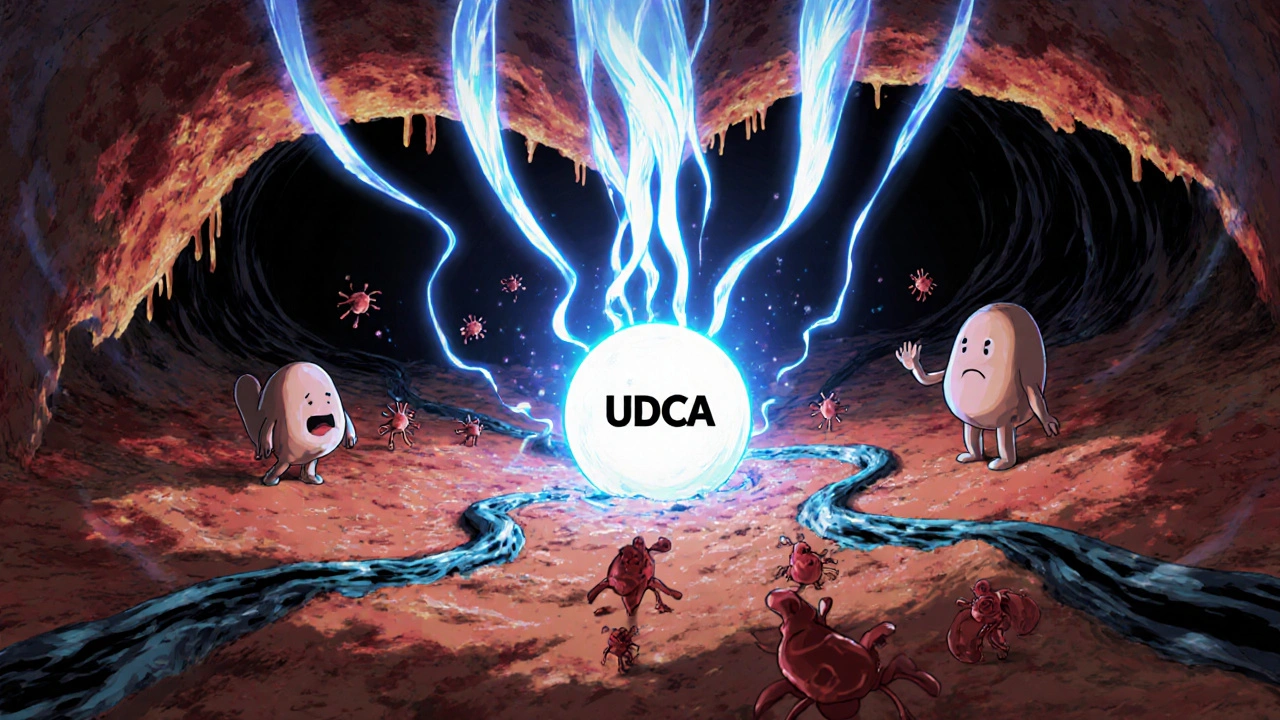
Health October 18, 2025
Ursodeoxycholic Acid: How It Helps Treat Alcoholic Liver Disease
Quick Takeaways
- Ursodeoxycholic acid (UDCA) improves bile flow and reduces inflammation in alcoholic liver disease (ALD).
- Clinical data show modest liver‑function improvement, especially in early‑stage fibrosis.
- UDCA can be combined with steroids or pentoxifylline, but dosing and patient selection matter.
- Side‑effects are rare; the main concerns are gallstone formation and rare hepatotoxicity at high doses.
- Current guidelines list UDCA as an adjunct, not a first‑line, therapy for severe alcoholic hepatitis.
What Is Ursodeoxycholic acid?
Ursodeoxycholic acid (UDCA) is a naturally occurring, hydrophilic bile acid first isolated from bear bile. In modern medicine it is synthesized for oral use and approved in many countries for primary biliary cholangitis and certain cholestatic disorders. Its main actions include: improving the composition of the bile‑acid pool, protecting cholangiocytes from toxic bile acids, and stimulating hepatic secretion of protective phospholipids.
Because ALD often features cholestasis, biliary injury, and oxidative stress, researchers have explored whether the same mechanisms can slow disease progression. The molecule’s low toxicity and oral availability make it attractive for long‑term use.
Understanding Alcoholic Liver Disease
Alcoholic Liver Disease (ALD) spans a spectrum from simple steatosis to alcoholic hepatitis, fibrosis, cirrhosis, and hepatocellular carcinoma. Chronic ethanol intake triggers three core pathways: (1) metabolic overload that produces toxic acetaldehyde, (2) oxidative stress through CYP2E1 activation, and (3) an inflammatory cascade driven by gut‑derived endotoxin.
Patients typically present with elevated liver enzymes, jaundice, and in severe cases, portal hypertension. The mortality of acute alcoholic hepatitis can exceed 30 % within 90 days, underscoring the need for effective adjunct therapies.
How UDCA Works in the Liver
Three mechanisms explain UDCA’s potential benefit in ALD:
- Cholagogue effect: UDCA promotes bile flow, reducing intra‑hepatic cholestasis that often accompanies alcoholic hepatitis.
- Anti‑apoptotic signaling: By modulating mitochondrial pathways, UDCA reduces hepatocyte death caused by acetaldehyde.
- Immunomodulation: UDCA dampens NF‑κB activation, leading to lower cytokine release (TNF‑α, IL‑6) that fuels inflammation.
Animal models of ethanol‑induced liver injury consistently show lower fibrosis scores when UDCA is added to a standard diet.

Evidence from Clinical Trials
Human data are less uniform, but several key studies shape today’s view:
- EURO‑ALD 2019: A double‑blind, 120‑patient trial of 13‑15 mg/kg/day UDCA for 24 weeks showed a 22 % reduction in serum bilirubin and a modest drop in AST compared with placebo. The effect was strongest in patients with Child‑Pugh A‑B disease.
- US Multi‑Center 2021: In 84 patients with severe alcoholic hepatitis (Maddrey’s Discriminant Function > 32), adding UDDA to standard prednisolone did not improve 90‑day survival, but liver‑function tests improved faster, allowing earlier tapering of steroids.
- Meta‑analysis 2023 (10 RCTs, 1,047 participants): Overall mortality advantage was non‑significant (RR 0.96), yet subgroup analysis revealed a benefit when UDCA was started before cirrhosis development (RR 0.84).
Guidelines from the American Association for the Study of Liver Diseases (AASLD, 2024) now list UDCA as a “conditional adjunct” for early‑stage ALD and for patients intolerant to steroids.
Comparing UDCA with Other ALD Treatments
| Therapy | Mechanism | Evidence Level (2024) | Typical Dose | Common Side‑effects |
|---|---|---|---|---|
| Corticosteroids | Anti‑inflammatory, suppresses cytokine storm | High (multiple RCTs, mortality benefit in severe hepatitis) | Prednisolone 40 mg/day, 28 days | Infection, hyperglycemia, GI bleed |
| Pentoxifylline | TNF‑α inhibition, improves microcirculation | Moderate (mixed RCT results) | 400 mg 3×/day | Nausea, dizziness |
| N‑acetylcysteine | Glutathione precursor, antioxidant | Low‑moderate (adjunctive, no mortality impact) | 1200 mg BID IV, then oral | Allergic reactions, rash |
| Silymarin | Flavonoid antioxidant, membrane stabilizer | Low (small trials) | 140 mg TID | Mild GI upset |
| Ursodeoxycholic acid | Cholagogue, anti‑apoptotic, immunomodulatory | Moderate (meta‑analysis, early‑stage benefit) | 13‑15 mg/kg/day divided BID | Diarrhea, rare gallstone formation |
When choosing a regimen, clinicians balance disease severity, comorbidities, and drug‑interaction risk. For a patient with early fibrosis who cannot tolerate steroids, UDCA alone or combined with silymarin may be a reasonable path.
Practical Guidance for Clinicians
- Screen every alcoholic patient for liver fibrosis using FibroScan or serum markers.
- If Child‑Pugh class A‑B and bilirubin < 3 mg/dL, consider starting UDCA at 13 mg/kg/day.
- Monitor liver enzymes, bilirubin, and alkaline phosphatase every 4 weeks.
- Re‑evaluate after 12 weeks: continue if ALT/AST drop > 25 % and no worsening of symptoms.
- Combine with a short course of prednisolone only if Maddrey’s DF > 32 and no active infection.
Educate patients about adherence-missed doses quickly erode the modest benefit. Lifestyle counseling remains the cornerstone; UDCA cannot replace abstinence.

Risks and Contra‑Indications
UDCA is well tolerated, but be aware of the following:
- Severe cholestasis caused by mechanical obstruction (e.g., gallstones) - UDCA may worsen stone formation.
- Pregnancy: data are limited; avoid high‑dose regimens unless benefits outweigh risks.
- Concurrent use of high‑dose cholestyramine - may reduce UDCA absorption.
Routine labs (CBC, liver panel) should be obtained at baseline and during therapy to catch rare hepatotoxicity early.
Future Directions
Research is now focusing on combining UDCA with newer bile‑acid receptors agonists like obeticholic acid. Early phase‑II trials suggest synergistic reduction in fibrosis markers, but safety profiles need clarification. Genomic studies also aim to identify which patients metabolize UDCA most efficiently, paving the way for personalized dosing.
Key Point Recap
Ursodeoxycholic acid offers a modest but real advantage in early‑stage alcoholic liver disease, especially when steroids are contraindicated or as part of a multi‑drug strategy. It is not a cure, but a useful tool in the clinician’s armamentarium.
Frequently Asked Questions
Can UDCA reverse cirrhosis caused by alcohol?
No. In advanced cirrhosis the architecture is largely fixed. UDCA may slow further damage and improve liver‑function tests, but reversal of established cirrhosis is not supported by current evidence.
How long should a patient stay on UDCA?
Most trials used a 6‑month course. If biochemical improvement is sustained and no side‑effects appear, clinicians often continue for 12 months before reassessing the need.
Is UDCA safe for patients with hepatitis C co‑infection?
Studies show UDCA does not worsen HCV viral load and may modestly improve cholestasis. However, it should not replace antiviral therapy and must be used under specialist supervision.
What dose is considered high‑risk?
Doses above 20 mg/kg/day have been linked to increased gallstone formation and rare hepatic injury. Stick to the 13‑15 mg/kg/day range unless a trial protocol dictates otherwise.
Can UDCA be taken with alcohol?
The therapeutic goal of UDCA is to mitigate alcohol‑related damage, but ongoing heavy drinking defeats its purpose. Patients should aim for abstinence or at least significant reduction while on therapy.
Write a comment
Items marked with * are required.






12 Comments
nitish sharma October 18, 2025 AT 19:43
The therapeutic landscape of alcoholic liver disease now includes several adjuncts that merit careful consideration. Among these, ursodeoxycholic acid stands out for its cholagogue and cytoprotective properties. Clinical experience suggests that initiating UDCA before the onset of decompensated cirrhosis can lead to measurable improvements in serum bilirubin and transaminase levels. The mechanism involves enhancement of bile flow, attenuation of mitochondrial apoptosis, and modulation of inflammatory signaling pathways. Moreover, UDCA's favorable safety profile permits long‑term administration in patients who are unable to tolerate corticosteroids. It is advisable to assess each patient’s Child‑Pugh classification, ensuring that candidates fall within class A or B before commencement. Dosing at 13 mg per kilogram of body weight, divided twice daily, aligns with the regimens demonstrated in recent randomized trials. Regular monitoring of liver enzymes, alkaline phosphatase, and bilirubin every four weeks facilitates timely adjustments. Should a patient exhibit a sustained decline of at least twenty‑five percent in ALT or AST, continuation of therapy is justified. Conversely, any emergent cholestatic pattern or gallstone formation warrants reevaluation of the treatment plan. Integration of UDCA with a brief course of prednisolone may expedite steroid tapering in selected cases, provided infection risk is minimal. It is essential to reinforce abstinence counseling concurrently, as pharmacologic benefits diminish in the presence of ongoing alcohol consumption. In practice, a multidisciplinary approach that includes hepatology, nutrition, and addiction services yields the most favorable outcomes. While UDCA does not reverse established cirrhosis, its capacity to slow disease progression has been corroborated by meta‑analytic data. Future investigations combining UDCA with novel bile‑acid receptor agonists hold promise for synergistic antifibrotic effects. Therefore, clinicians should regard UDCA as a valuable component of early‑stage ALD management, implementing it judiciously within individualized treatment algorithms.
Rohit Sridhar October 19, 2025 AT 23:30
Seeing the data on ursodeoxycholic acid can feel like a breath of fresh air for patients battling early‑stage alcoholic liver disease. The modest yet consistent drops in bilirubin and transaminases give us hope that liver function can be steadied. When steroids are off the table, UDCA becomes a reliable sidekick, especially for those who struggle with compliance. Remember, the key is to pair the medication with solid lifestyle counseling-no pill can replace sobriety. Regular follow‑up every month helps catch any wobble early, keeping the therapeutic momentum alive. If you notice a steady decline in liver enzymes, keep the course; if not, reassess promptly. The bottom line: optimism paired with diligent monitoring can make UDCA work wonders for many.
Linda A October 21, 2025 AT 03:16
In the quiet corridors of hepatic resilience, one may contemplate the subtle poetry of bile acids. Ursodeoxycholic acid, a humble molecule, whispers promises of cellular equilibrium. Yet, the clinical dance remains restrained, each study a measured step. The evidence does not roar; it murmurs-an invitation to observe rather than dictate. Thus, the practitioner stands as a silent witness to incremental change.
Joe Moore October 22, 2025 AT 07:03
Yo, they don’t want u to know that the pharma giants push UDCA just to keep us hooked on meds. The studies are cherry‑picked, man, and the real cure is out there-just stay off the booze. Dont trust the “guidelines”, they’re written by the same folks pulling the strings. It’s all a big game, bro.
Poornima Ganesan October 23, 2025 AT 10:50
Let’s set the record straight: ursodeoxycholic acid is not a miracle cure, but its pharmacodynamics are well‑documented. It enhances the hydrophilic bile‑acid pool, stabilizes mitochondrial membranes, and attenuates NF‑κB signaling-three mechanisms that are repeatedly validated in peer‑reviewed literature. The dosage of 13–15 mg/kg/day is optimal; exceeding 20 mg/kg risks lithogenesis and paradoxical hepatotoxicity. Moreover, patient selection is critical: those with Child‑Pugh A‑B and bilirubin under 3 mg/dL derive the most benefit. Ignoring these parameters leads to anecdotal failures that tarnish the drug’s reputation.
Emma Williams October 24, 2025 AT 14:36
True points there but keep it simple. UDCA works best early and you need labs to watch it. No need for fancy talk.
Stephanie Zaragoza October 25, 2025 AT 18:23
Indeed, the therapeutic index of ursodeoxycholic acid, when administered within the 13–15 mg·kg⁻¹·day⁻¹ window, is decidedly favorable; however, clinicians must remain vigilant, as elevations in alkaline phosphatase may signal subclinical cholestasis, necessitating dose adjustment or discontinuation. Furthermore, the interplay between UDCA and concomitant corticosteroid regimens, particularly in patients with a Maddrey’s Discriminant Function exceeding 32, warrants meticulous monitoring, given the potential for synergistic immunosuppression.
James Mali October 26, 2025 AT 21:10
Honestly, the hype around UDCA feels a bit overblown. It’s a modest tool, not a silver bullet.
Janet Morales October 28, 2025 AT 00:56
Don’t underestimate the quiet power of a modest adjunct; dismissing UDCA as “overblown” ignores the lives it stabilizes. While it won’t cure cirrhosis, it can buy precious weeks for patients clinging to sobriety. The drama isn’t in the drug itself but in the relentless progression of unchecked alcohol abuse. So, let’s give credit where it’s due and not rush to vilify a well‑studied therapy.
Tracy O'Keeffe October 29, 2025 AT 04:43
Ah, the saga of ursodeoxycholic acid-truly the opera of hepatology! One must appreciate the intricate ballet of bile‑acid modulation, a choreography that waltzes between cholestasis alleviation and apoptosis inhibition. Yet, the critics, ever the cynics, reduce this masterpiece to mere “modest benefits”. Such reductionism betrays a shallow grasp of biochemical nuance. When we whisper the term “adjunct”, we speak of a cunning sidekick, not a dim‑witted footnote. Embrace the lexicon of bile‑acid receptors, and you’ll see the future of antifibrotic therapy glimmering on the horizon. In short, UDCA is the unsung troubadour in the concert of liver recovery.
Rajesh Singh October 30, 2025 AT 08:30
While the poetic flair is entertaining, let us not lose sight of ethical responsibility. Prescribing UDCA without emphasizing abstinence is tantamount to moral complacency. The drug offers support, not absolution; patients must own their recovery journey. Any therapeutic plan that sidesteps this truth risks becoming an excuse for continued indulgence. Hence, clinicians bear the duty to couple medication with unwavering sobriety counseling.
Albert Fernàndez Chacón October 31, 2025 AT 12:16
UDCA can help, but stopping drinking is still key.